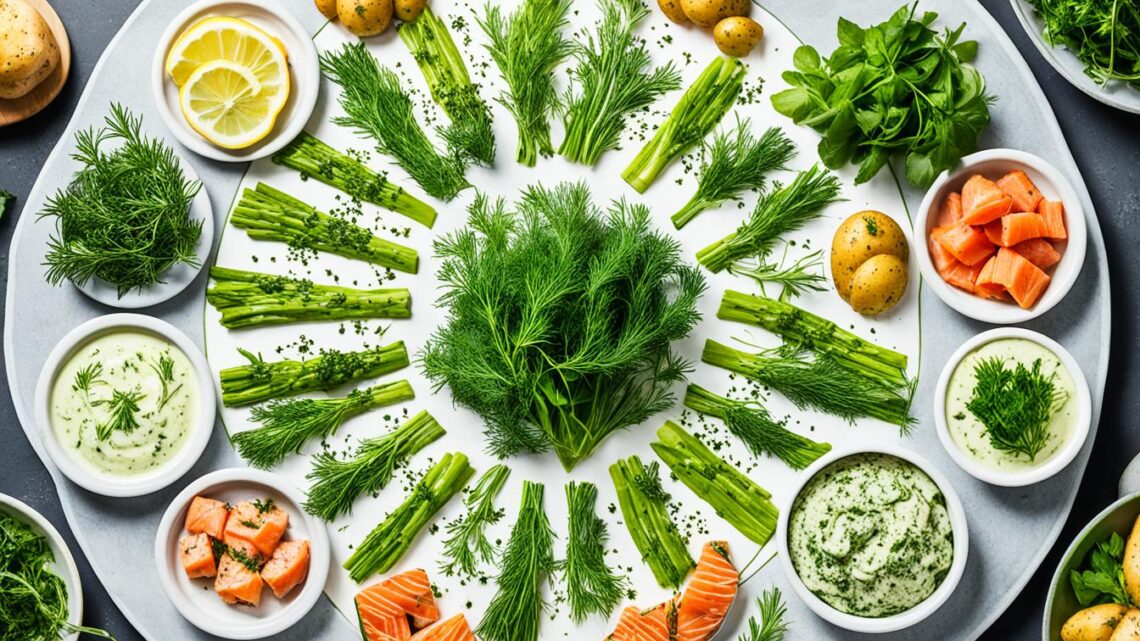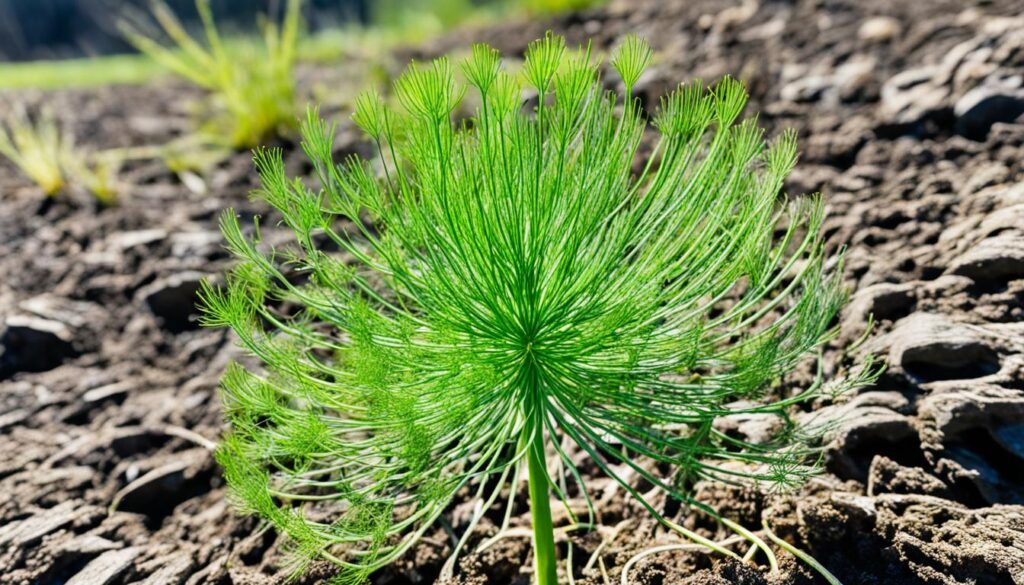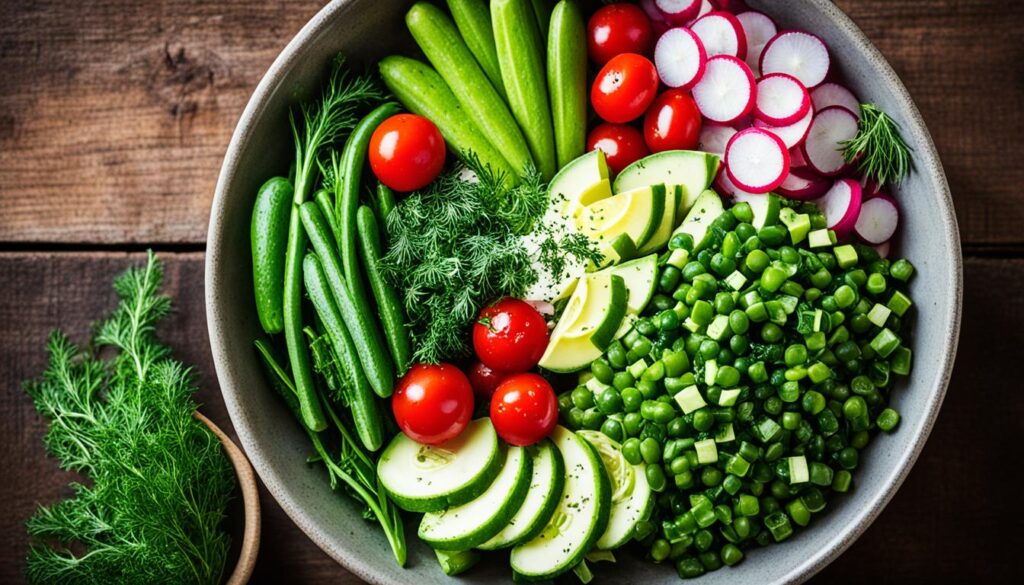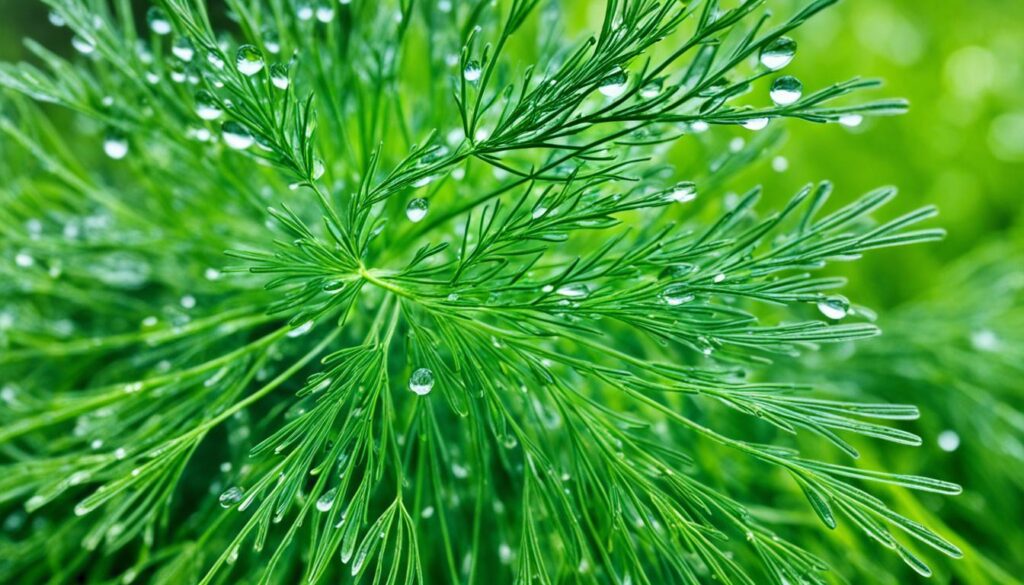
Welcome to the world of dill, a fragrant herb loved for its flavor and versatility. This article will show you the health perks of dill and its many uses in cooking. You’ll learn how dill can make your dishes taste better and is good for you. Plus, get tips on growing dill in your garden and fresh recipes to try.
Dill comes from the Mediterranean and America. It’s more than just an herb; it’s a way to make your food taste amazing!
Understanding Dill: A Brief Overview
Dill, known as Anethum graveolens, is a popular herb. It’s loved for its unique smell and taste. The feathery, green leaves make it stand out in gardens and kitchens.
Dill grows best in warm places and well-drained soil. It’s a top choice for gardeners at home.
There are two main types of dill: leaf dill and seed dill. Leafy dill is great for cooking and adds freshness to food. Seed dill is used for pickling and seasoning. Knowing the difference helps you pick the right type for your recipes.
Growing dill is easy and needs little care. It does well in the sun and with regular water. Dill looks good with other herbs, making your garden more beautiful and useful.
Dill has a long history, dating back to ancient Egypt. It was valued for its taste and healing powers.
Dill is important in many cuisines worldwide. It’s used in Scandinavian and Middle Eastern dishes, showing its wide appeal and versatility.
Health Benefits of Dill
Dill is more than just a tasty herb. It has many health benefits that help keep you healthy. Adding dill to your meals gives you important vitamins and minerals.
Nutritional Profile of Dill
Dill is amazing for its nutrition. It has few calories but lots of Dill vitamins and minerals. Here’s what you get from one tablespoon of fresh dill:
| Nutrient | Amount per 1 tablespoon (fresh) |
|---|---|
| Vitamin A | 8% of the Daily Value (DV) |
| Vitamin C | 5% of the DV |
| Manganese | 4% of the DV |
| Calcium | 3% of the DV |
The nutritional benefits of Dill come from both fresh and dried forms. Dried dill has more nutrients, making it great for your diet.
Antioxidant Properties of Dill
Dill has strong Dill antioxidant compounds that fight oxidative stress. This stress can cause chronic diseases. Dill’s flavonoids and terpenoids protect you by fighting free radicals. This boosts your Dill health properties.
Using dill in your meals does more than just taste good. It also helps your body fight damage from the environment and aging. Learn more about the health perks of herbs here.
Uses for Dill in Cooking
Dill is a favorite in the kitchen for its unique taste and smell. It makes many dishes better. It’s great in salads, soups, and with seafood, showing its many uses.
Dill Seasoning: Enhancing Flavors
Dill is a top choice for adding flavor to food. It works well in both light and rich dishes. For instance, it adds a fresh taste to potato salad and depth to creamy dressings.
It’s also key in pickling, making vegetables taste lively. Try using dill in buttermilk dressings or marinades for chicken and fish. This adds a perfect balance to your dishes.
Pairing Dill with Other Ingredients
Dill goes well with many foods. You might enjoy it with:
- Cucumbers
- Yogurt
- Lemon
- Garlic
These ingredients and dill make a refreshing mix. Tzatziki is a classic dish that uses this mix well. Or, try it in a salad with cherry tomatoes and chickpeas, or as a marinade for grilled fish.
These pairings make any meal better. By trying these ideas, you can make dill the star of your meals.
Dill: Benefits Beyond the Kitchen

Dill is more than just a spice; it has medicinal properties that have been used for years. This herb is a key part of traditional medicine. It helps with many health issues, showing its value beyond cooking.
Medicinal Uses of Dill
Dill is great for your stomach. It can ease bloating and gas, making it a top choice for Dill for natural remedies. The oil from dill seeds also fights germs and reduces swelling, boosting your health.
Adding dill to your daily life can make a big difference in your health.
Dill in Aromatherapy
The sweet smell of dill essential oil is popular in aromatherapy. It helps calm nerves and makes you feel relaxed. People love the Dill essential oil benefits in diffusers or in personal care items.
Trying Dill aromatherapy uses can make your space peaceful. It can lift your mood and improve your overall well-being.
Growing Dill: Tips for Your Garden
Growing Dill can make your garden and cooking better. It needs sunny, warm spots with rich, well-drained soil. Make sure to water it right and let the soil dry a bit before watering again. Spring or early autumn are the best times to plant when it’s not too hot or cold.
Best Conditions for Dill Planting
Here are some tips for growing Dill:
- Sunlight: Your Dill needs 6-8 hours of sunlight every day.
- Soil Type: Use fertile, loamy soil that drains well to prevent root rot.
- Watering: Water regularly, but don’t overwater to stop it from getting too wet.
- Fertilization: A balanced fertilizer helps it grow strong in the early days.
Companion Plants for Dill
Planting Dill with other plants can make it grow better and keep your garden healthy. Dill gets along well with many plants, making them great neighbors:
| Companion Plant | Benefits |
|---|---|
| Cucumbers | Improves growth and repels pests. |
| Tomatoes | Enhances flavor and growth rate. |
| Basil | Repels harmful insects while promoting Dill growth. |
Using these tips helps with your Dill plant care and adds herbs that benefit Dill to your garden. With the right care and friends, you’ll have a thriving Dill crop for your recipes.
Culinary Uses: Cooking with Dill
Dill is a versatile herb that makes many dishes better. It’s great for seafood, salads, or sauces. Using fresh or dried dill can change your cooking.
Seafood lovers will love how dill goes with grilled fish and shellfish. A bit of fresh dill can make grilled salmon taste amazing. Dill also makes salads taste better. Mixing it with cucumbers makes a cool salad for summer.
You can also add dill to creamy dressings. This gives a nice contrast to rich foods.
- For a quick dip, blend dill with yogurt and herbs.
- Mix fresh dill into potato salads for an extra zing.
- Use dill as a garnish on soups to add visual appeal and flavor.
When using dill, remember it has a strong taste. A little is enough, especially with dried dill. Adding dill at the right time is key. Try different times to see what you like best.
Dill Preservation Methods
Preserving dill keeps its flavor and nutrients all year. Knowing how to keep dill fresh is key. Freezing and making dill oil and vinegar are great ways to enjoy dill in any season.
Freezing Dill for Later Use
Freezing dill is easy and keeps its taste. Start by washing the dill to get rid of dirt or bugs. Then, dry it well to stop clumps when you freeze.
After drying, chop the dill or leave it whole if you like. Put it in airtight freezer bags, squeezing out the air. Or, use ice cube trays with chopped dill and oil or water. Once frozen, move the cubes to bags for easy use in recipes.
Making Dill Oil and Vinegar
Make dill oil and vinegar to add a special flavor to your dishes. Start with fresh dill, washing and drying it well. For dill oil, warm some oil like extra virgin olive oil in a pan. Add the dill and simmer for 10 minutes. Let it cool, then strain and store the oil in a dark place.
To make dill vinegar, mix fresh dill with vinegar in a jar. Keep it in the fridge for two weeks, shaking it now and then. This vinegar adds a fresh dill taste to salads and marinades.
| Method | Description | Storage Duration |
|---|---|---|
| Freezing Dill | Wash, dry, chop, and pack in airtight bags or ice cube trays. | Up to 6 months |
| Dill-infused Oil | Simmer fresh dill in warm oil, cool, and strain. | Up to 1 month in a cool place |
| Dill-infused Vinegar | Combine fresh dill with vinegar and steep for two weeks. | Up to 1 year in the fridge |
Using these methods keeps dill fresh all year. Try dill oil, vinegar, and frozen dill to make your cooking better.
Fresh Dill Recipes to Try

Dill makes dishes taste better and adds freshness. It’s great for summer or parties. Here are some Fresh cucumber salad and Dill pickle recipe ideas that highlight dill’s flavor.
Cucumber and Dill Salad Recipe
This Fresh cucumber salad is perfect for hot summer days. You’ll need these ingredients:
- 2 large cucumbers, sliced
- 1/4 cup fresh dill, chopped
- 1/4 cup red onion, thinly sliced
- 1/4 cup vinegar (your choice)
- 1 tablespoon olive oil
- Salt and pepper to taste
Put all ingredients in a bowl and mix well. Serve it cold with your favorite dish. For more ideas, check out this Chickpea Pasta Salad.
Easy Dill Pickles Recipe
This Dill pickle recipe is easy and doesn’t need special tools. Here’s how to make tasty pickles:
- 14 pickling cucumbers
- 25 sprigs of fresh dill
- 4 cloves of garlic
- 1 cup apple cider vinegar
- 1/2 cup sugar
- 1/3 cup salt
- 2 quarts water
Start by mixing water, vinegar, sugar, and salt in a pot. Heat until everything dissolves. Then, fill jars with cucumbers, dill, and garlic. Pour the brine over them and seal the jars. Keep them in the fridge for 48-72 hours to let the flavors blend. For quick pickling, use the Quick pickling with Dill method for fast results!
Dill in Popular Cuisines Around the World
Dill is a tasty herb used in many Dill in international cuisines. In Scandinavian countries, it’s a key part of gravlax, a dish with cured salmon. It makes the fish taste better.
In the Mediterranean, dill is a big deal in global uses of Dill. It’s in tzatziki, a Greek dip with yogurt, cucumber, and garlic. This dip is great with bread and meat. Eastern Europe loves dill too, using it in soups like borscht and pickling brines.
In the Middle East, dill is used a lot in dishes like Persian flatbreads and salads. Its crunchy texture and mild taste are perfect with rich foods.
Dill is also used in grilled tri-tip steak sandwiches, with dill seed in the mix. This shows how dill can improve even big, hearty dishes. This recipe shows dill’s wide range of uses.
| Cuisine | Dish | Use of Dill |
|---|---|---|
| Scandinavian | Gravlax | Curing salmon with dill |
| Mediterranean | Tzatziki | Flavor in yogurt and cucumber dip |
| Eastern European | Borscht | Aromatic addition to beet soup |
| Middle Eastern | Herb-stuffed flatbreads | Adds fresh flavor to baked goods |
| American | Grilled tri-tip sandwiches | Included in seasoning mix |
This table shows how dill is used in many cuisines. It’s loved for its unique taste. Exploring global uses of Dill, you’ll see it adds a special touch to dishes.
Exploring Dill Herbiculture

The herbiculture of Dill is key to enjoying its many benefits. Learning how to farm dill sustainably makes for healthier plants and more produce. This part talks about how to grow dill, the challenges it faces, and how to solve these problems.
Cultivation Practices for Dill
Here are some tips for growing dill well:
- Soil Preparation: Make sure the soil is rich, drains well, and is a bit acidic or neutral with a pH of 6.5–7.0.
- Sowing Seeds: Plant dill seeds in the garden after the last frost in spring.
- Sunlight Requirements: Give dill full sun for 6 to 8 hours a day for best growth.
- Watering: Keep the soil moist, especially when the seeds are germinating. Dill likes temperatures between 60° and 70°F (15° and 21°C).
- Crop Rotation: Rotate crops to keep the soil healthy and stop it from getting worn out.
Common Issues Encountered with Dill Plants
Even though dill is tough, it can face some problems. Knowing about these issues helps you deal with them:
- Pests: Aphids and spider mites can bother dill, so check on it often.
- Diseases: Watch out for fungal infections that can cause mold or rot in damp spots.
- Environmental Stress: Changes in temperature and uneven watering can stress out the plants and make them grow poorly.
- Beneficial Insects: Let wasps and other helpful insects help control pests naturally.
Learning how to farm dill sustainably helps you beat these pests and diseases of dill. You can then enjoy a great harvest. For more gardening tips, check out unique varieties and how to grow them, like the Panda Face Ginger.
Incorporating Dill into Your Daily Diet
Dill is a versatile herb that makes meals better and is good for your health. It’s easy to add to your cooking and can change your meals for the better. Here are some easy ways to use Dill in your meals.
- Mix fresh dill into scrambled eggs for a flavorful breakfast boost.
- Add dill to soups and stews to introduce a aromatic, herbal note.
- Stir dill into sauces, enhancing both taste and nutritional value.
- Top salads with fresh dill, giving a fresh twist to your greens.
- Incorporate dill into marinades for meats, enhancing your barbecue experience.
These are just a few ways to use Dill every day. Adding Dill to your meals makes cooking fun and is good for you.
Expert Tips for Using Dill Effectively
Dill is a versatile herb that can make many dishes better. Knowing how to handle it right will make sure you enjoy its unique taste. With the right Dill storage tips, your dill will stay fresh longer. Knowing the differences between fresh vs. dried dill helps you pick the best one for your recipes.
Storing Fresh Dill for Longevity
Keeping fresh dill is key to enjoying its bright flavor. Here are some top Dill storage tips:
- Wrap fresh dill in a damp paper towel and put it in a sealed plastic bag. Keep it in the fridge’s veggie drawer for up to a week.
- Or, put the stems in a jar with water and cover the leaves with a plastic bag. This keeps the herb fresh for about a week too.
- For longer storage, freeze dill. Chop it and fill an ice cube tray with water or olive oil. Once frozen, move the cubes to a sealed freezer bag.
Fresh vs. Dried Dill: When to Use Each
Knowing the differences between fresh vs. dried dill helps you pick the best for your recipes:
| Aspect | Fresh Dill | Dried Dill |
|---|---|---|
| Flavor Intensity | More vibrant and aromatic | Concentrated but can be less impactful |
| Best Uses | Salads, dressings, and finishing touches | Long-cooked dishes, marinades, and soups |
| Shelf Life | Short; lasts about a week | Long; can last for several months |
Using these tips on both forms of dill can improve your cooking. Knowing when to use fresh or dried dill can make your dishes taste better. This way, your dill will always be at its best.
Popularity and Cultural Significance of Dill
Dill has a rich history, loved for its unique taste and many uses. It’s popular in many places and times, playing a big role in food and traditional medicine. From old times to today, people around the world value dill for its flavor and health perks.
Long ago, dill was used for more than just cooking. It helped with digestion and kept people healthy. Old texts show how important dill was for keeping food fresh and tasty. This proves dill’s key role in history.
Now, dill is still a favorite in kitchens everywhere, adding flavor to many dishes. Its impact can be seen in new recipes and cooking styles. This shows how dill’s legacy and flexibility have lasted through the ages. For more on herbs and vegetables in cooking, check out this essential guide on onions.



